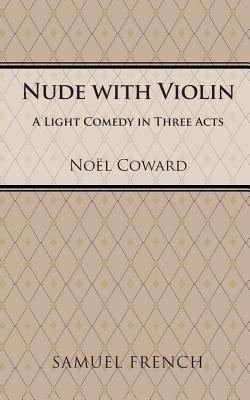6.6 /10 1 Votes6.6
Originally published 1900 | 3.3/5 Goodreads | |||||||||||||||||||||||||||||||||
 | ||||||||||||||||||||||||||||||||||
Similar Noël Coward plays, Other plays | ||||||||||||||||||||||||||||||||||
nude with violin by noel coward extended promo
Nude with Violin is a play in three acts by Noël Coward. A light comedy of manners, the play is Coward's satire on "Modern Art", criticism, artistic pretension and the value placed on art.
Contents
- nude with violin by noel coward extended promo
- Nude with violin 2013 05 11 excerpt 1
- Background and productions
- Characters and original cast
- Plot
- Critical reaction
- References
Its original London production, opening in 1956, was successful, running for more than a year. However, it failed to match the popularity of his pre-war hits and has rarely been professionally revived.
Nude with violin 2013 05 11 excerpt 1
Background and productions
Coward had not written a commercial theatrical success since his 1945 revue Sigh No More. After World War II, despite his hard work for his country during the war, Coward "was unpopular as a tax exile, and was berated by the British press. ... He was seen as a figure from the past". His 1955 Las Vegas night club act was a hit, leading to popular American TV appearances, including a successful 1956 TV adaptation of Blithe Spirit. Nude With Violin began a series of well-written and successful, but critically shunned, new plays in the late 1950s. Coward regained his popularity by the mid-1960s.
After a tour beginning at the Olympia Theatre, Dublin on 24 September 1956, the play opened on 8 November 1956 at the Globe Theatre in London's West End, starring John Gielgud, co-directed by Gielgud and Coward. It ran until 1 February 1958. During the run, Michael Wilding and later Robert Helpmann took over the lead role of Sebastien.
The production opened at the Belasco Theatre on Broadway in November 1957, starring the author, with Morris Carnovsky, Joyce Carey and Luba Malina, and playing for 86 performances. The production won the 1958 Tony Award for Best Scenic Design. It then had a US national tour. Robert Helpmann led the cast in a tour of Australia after the play closed in London in 1958, and also in a televised version broadcast in the UK in 1959. A different television version aired in 1964 in Melbourne, Australia, starring Terry Norris.
In Coward's centenary year, 1999, the play was mounted at the Royal Exchange, Manchester, starring Derek Griffiths as Sebastien, Marcia Warren as the hoaxer's widow, Tamzin Malleson as his forthright daughter, and Nick Caldecott as the young journalist. Marianne Elliott directed.
Characters and original cast
Plot
The play is set in Paris in 1954. The famous painter, Paul Sorodin, has died. His relatives and hangers-on converge on his studio, hopeful of financial gain, and are stunned to learn from his valet, Sebastien, that Sorodin has left a letter in which he admits that he never painted a picture in his life. The paintings of Sorodin's supposed three major periods turn out to have been executed by a choleric aristocrat, Anya Pavlikov; a jolly barmaid, Cherry-May Waterton; and a Jamaican Seventh-day Adventist, Obadiah Lewellyn.
Critical reaction
The reviews were polite but not laudatory. The Manchester Guardian called the play "good entertainment" but felt that Coward's subject, hypocrisy about modern art, was stale. The Times liked the idea of a celebrated painter who turns out never to have painted anything, but found it "apparently incapable of developments... Mr Coward can only proceed to play variations on it. Some of them are cosily amusing but... the author is left in the end trying rather desperately to lure us into the belief that the perpetrator of the monstrous 'Nude with Violin' is the artful valet himself."
The Observer critic Kenneth Tynan said that the play "recalls those triumphant Letters to the Editor which end: 'What has this so-called "Picasso" got that my six-year-old daughter hasn't?'.... When Sir John Gielgud appears in modern dress on the London stage for only the second time since the late nineteen-forties, selecting as his vehicle Noël Coward's Nude with Violin, one's expectations are naturally low. Sir John never acts seriously in modern dress; it is the lounging attire in which he relaxes between classical bookings, and his present performance as a simpering valet is an act of boyish mischief, carried out with extreme elegance and the general aspect of a tight, smart, walking umbrella."
